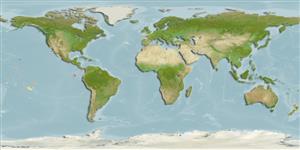Common names from other countries
Classification / Names / Names
ماع يماسا | فدارتم | Catalog of Fishes (gen., sp.) | ITIS | CoL | WoRMS
Environment: milieu / climate zone / depth range / distribution range
يسانش موب
; روش بل; قمع تارييغت 1 - 2 m (Ref. 101353). Temperate
Eastern Central Pacific and Northeast Atlantic: Mexico, Panama and UK.
Length at first maturity / Size / Weight / نس
Maturity: Lm ? range ? - ? cm Max length : 25.0 cm SHL يسنج صاوخ نودب / رن سنج; (Ref. 101485)
Depth range is based on occurrence in Mexico (Ref. 101353); to be replaced with a better reference. Mostly inhabits the intertidal zone (Ref. 106881). Found in mangroves (Refs. 101351, 106881), estuaries and coastal lagoons associated with mangrove roots (Ref. 106881). Eurythermal and euryhaline (Ref. 106881).
Life cycle and mating behavior
غولب | لثم دیلوت | یزیر مخت | اه مخت | Fecundity | )ورال ( دازوت
Members of the class Bivalvia are mostly gonochoric, some are protandric hermaphrodites. Life cycle: Embryos develop into free-swimming trocophore larvae, succeeded by the bivalve veliger, resembling a miniature clam.
یلصا ذخآم
عجارم | هدننك گنهامه | ناراكمه
The British Flora and Fauna Database. 2007. (Ref. 8593)
NCUI زمرق تسرهف رد تيعضو (Ref. 130435)
ستياس رظن زا تيعضو (Ref. 108899)
Not Evaluated
Not Evaluated
یناسنا هدافتسا
تاليش – يريگ يهام: يراجت
FAO - يرورپ يزبآ: production; | FishSource | Sea Around Us
اهرازبا
يتنرتنيا عبانم
Estimates based on models
Preferred temperature
(Ref.
115969): 12.4 - 26.9, mean 19 (based on 123 cells).
یگدنهج
دايز, هام 51 زا رتمك ، تيعمج ندش ربارب ود يارب مزال نامز هنيمك (K=1.08-1.1).
